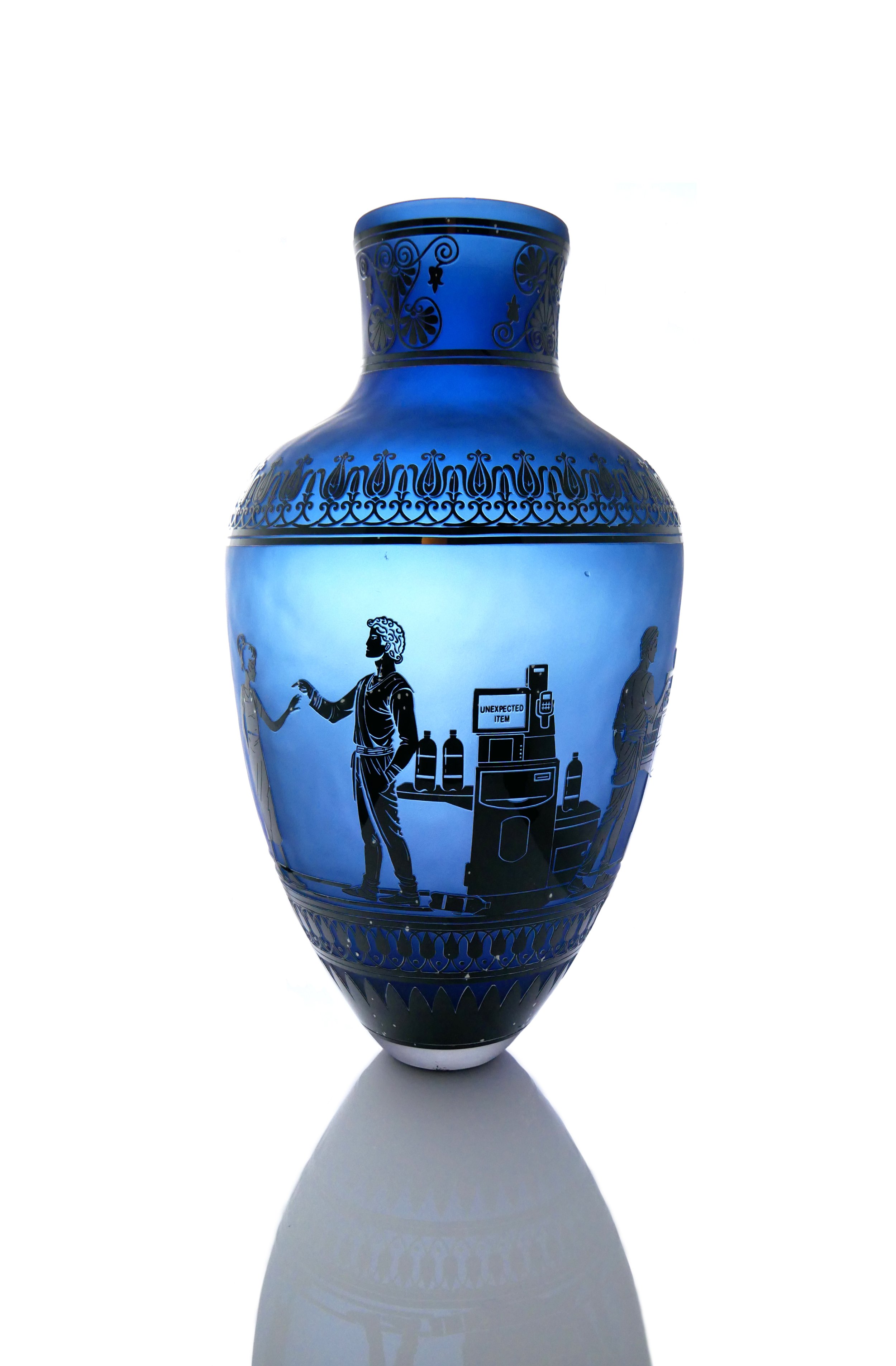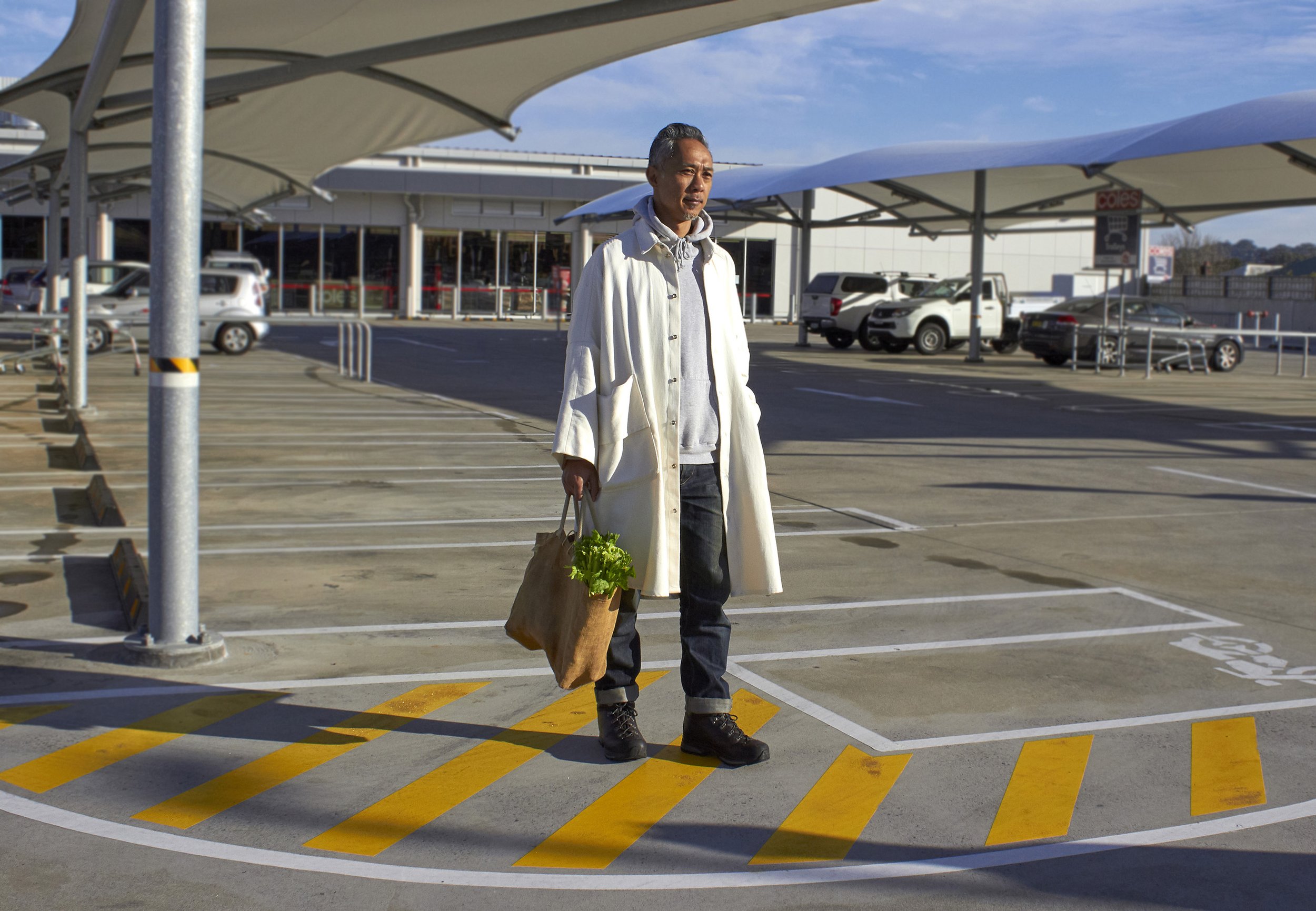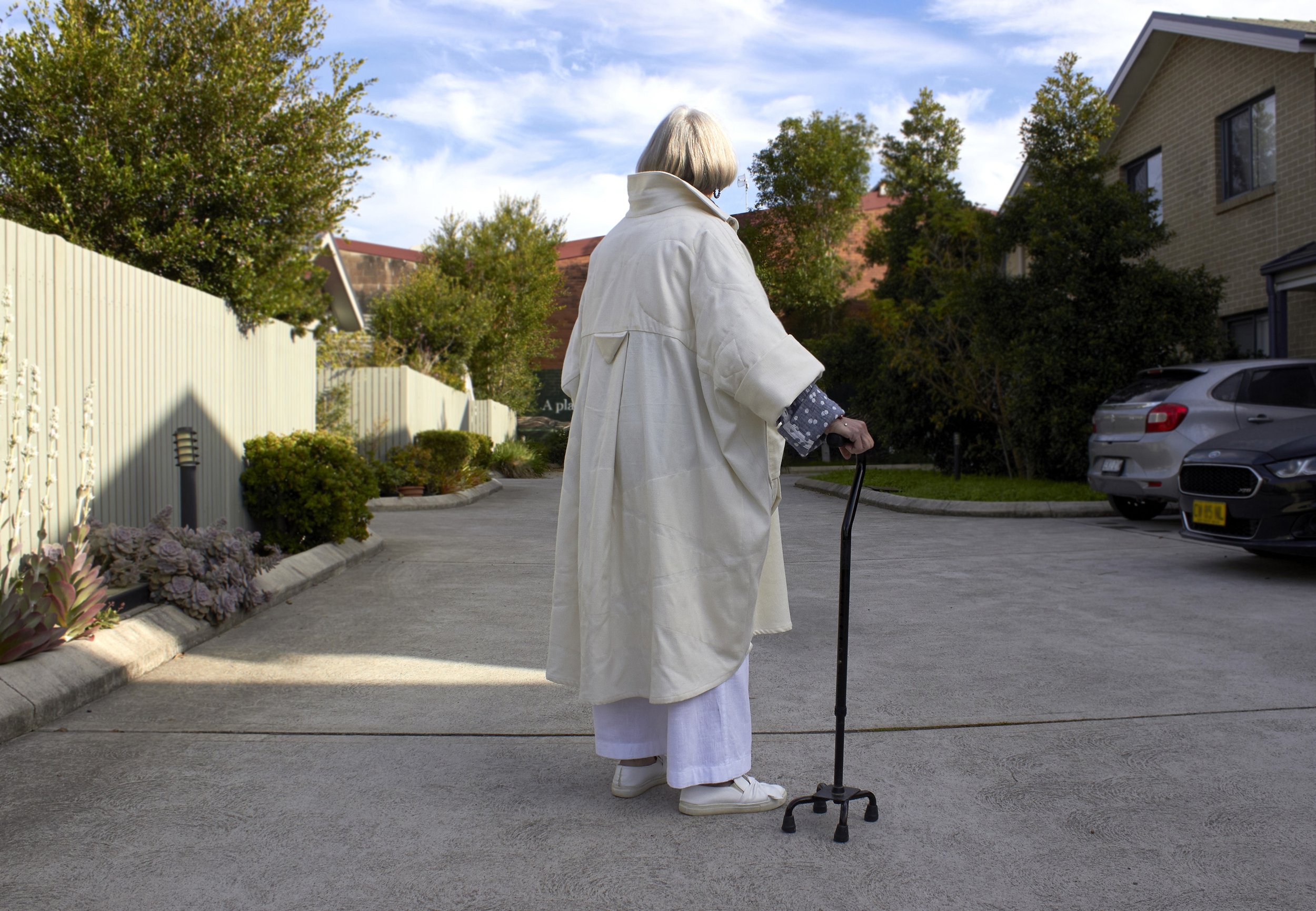MAKE Award: Biennial Prize for Innovation in Australian Craft and Design
The inaugural MAKE Award: Biennial Prize for Innovation in Australian Craft & Design finalists have been announced – we chat to finalists Rowena, Juliana and Angela Foong from High Tea with Mrs Woo, Jessica Murtagh and Tim Noone & Studio Ventana.
Words: Hande Renshaw I Photography: Matt Turner, Saskia Wilson & High Tea with Mrs Woo
‘With fast fashion being such an obvious problem, our creative collaboration as High Tea with Mrs Woo is a working example of what a slow fashion practice can do and model as a solution for the way we can make and wear clothing sustainably,’ says Rowena Foong, pictured with Juliana and Angela Foong from High Tea with Mrs Woo. Photo: Courtesy of High Tea with Mrs Woo
MAKE Award finalist, Tim Noone, in his Sydney workshop. Photo: Saskia Wilson
Self checkout of Sisyphus, 2023 by MAKE Award finalist, Jessica Murtagh.
Photo: Matt Turner
The Peregrine Dining Table by Studio Ventana and Tim Noone . Photo: Saskia Wilson
The Resilience Coat by High Tea with Mrs Woo. Photo: Courtesy of High Tea with Mrs Woo
The MAKE Award: Biennial Prize for Innovation in Australian Craft and Design is a new national award for Australian designer makers celebrating innovation in contemporary craft and design. Launched in April 2023, the award is an initiative of Australian Design Centre in Darlinghurst, Sydney.
The MAKE Award is the richest non-acquisitive prize for craft and design in Australia. The winner will receive a cash prize of $35,000 and a second prize of $10,000 will be awarded. The MAKE Award's objective is to recognise and celebrate the rich and diverse creative skills within the field of craft and design in Australia.
‘Australia has a wealth of creative talent and this new award aims to give an elevated platform to that talent, shining a spotlight on the energy and innovation in craft and design practice,’ said Lisa Cahill, CEO and Artistic Director of Australian Design Centre.
A total of 187 entries were received from Australian designer makers working across the fields of ceramics, glass, furniture/woodwork, metalwork, textiles and fibre, and contemporary jewellery. Designer makers were encouraged to submit a work that demonstrated innovation in technique or material use, and is an extension of their usual practice. There were 30 finalists that were chosen in August – we were lucky to chat to three of them about their design journey and inspiration: Studio Ventana, Tim Noone, Jessica Murtagh and sisters, Rowena, Juliana and Angela Foong, from High Tea with Mrs Woo.
STUDIO VENTANA X TIM NOONE
Peregrine Dining Table
Both based in Sydney, Alex Frocht, Studio Ventana director, is an architect, artist and designer and Tim Noone is a furniture maker. The duo designed the Peregrine Dining Table in collaboration – inspired by traditional spear throwing implements and spearheads, as well as the talon of the Peregrine falcon.
‘The design is not a copy of anything in particular, it’s not meant to mimic anything, for example a spear thrower, a weapon or a boomerang, but it has its essence. You may not see it immediately, but there’s a dialogue with those objects,’ shares Alex.
The idea for the design of the Peregrine Dining Table presented itself to Alex after he was gifted a 1900s boomerang many years ago. He was fascinated by the manual aspect of the object and the way the timber resisted the form. ‘From an intuitive viewpoint I thought that somebody had created this object with the most primitive tools that had a tremendous amount of spirit to it. Previously my work was utilitarian, so I wanted to make a piece which had a real sense of spirit - I worked on the idea for a long period, which evolved over time,’ he says.
The table is made entirely of solid wenge - an African hardwood. Several species entered the conversation when experimenting with different types of timbers, and how to express the shape and detailing of the table. It was decided that only solid wenge would do the design justice.
‘One of the nice things about the timber we used is that 95 per cent of the top of the table is from one giant slab, which had been sitting in a timber yard for 20 years - it was nice to be able to produce something with that consistency, colour and grain,’ says Tim.
Great care was taken to ensure the economical use of the Wenge - particularly in the production of the legs. While they might seem unassuming, constructing the legs from large blocks would have required removing at least two-thirds of the material. Therefore, they were assembled using smaller tapered blocks to minimise waste.
Alex’s work leans heavily on the theory of architecture. When he approaches a project, it’s important to try to find its true nature and spirit. ‘From my view point there are three different components of when you design: there’s the formal aspect of the design, the symbolic aspect and then the historical aspect of the design – they need to have a seamless amalgamation.’
JESSICA MURTAGH
Self checkout of Sisyphus, 2023
Adelaide-based Jessica Murtagh is an artist who has recently started exploring working with glass. Coming from an arts practice focused on illustration, she uses sand carving and engraving techniques to create narratives on glass. Jessica draws inspiration from classical artefacts of past societies, such as the ancient Athenians, which are a constant in her work.
‘I’m a big history buff and classical history was one of my favourite things growing up, and even though I love ancient historians Athenian Attic, I love that there are so many clues you can garner from their artefacts – you have an idea of their ceremonies and rituals,’ shares Jessica.
Self checkout of Sisyphus is a direct parallel to Sisyphus – the self checkout lane has become an eternity of futile labour as a form of hideous punishment. A modern and common scene played out in supermarkets, the dreaded ‘unexpected item in bagging area’ flashes on screens across the globe - much to the consternation of all involved. While a source of fury for many, it is these mundane moments that are some of the great levellers of society.
‘My favourite ancient piece is actually the most mundane of all: a collection of women gathering water from a fountain. It’s a really normal act and I love the idea of it – yes, there’s plenty of godly deeds that the Athenians like to draw on their pottery, but I really love the everyday stuff. I feel like we’re all familiar with these mundane moments. They’re great levellers, we have this thing in common, yet we’re all so different. There is so much that makes us the same… it’s these small moments that bring us together.’
For Jessica, the art of glass blowing is very much a team effort, which she feels fortunate to be able to share and also lean on other artists when she needs. ‘Glass blowing is a team sport and I have three people in my team – Emma Young, Marcel Hoogstad Hay and Drew Spangenburg, I attribute all the successes in my glass journey to these three people. They taught me how to blow glass, they assist me, still teach me – I am enormously grateful to them.’
“Australia has a wealth of creative talent and this new award aims to give an elevated platform to that talent, shining a spotlight on the energy and innovation in craft and design practice.”
‘We wake up every morning and put on our Resilience Coat because every day we confront, and we are confronted. Everyday this coat offers its shape for protection, its folds for adventure, exploit and ordeal. It’s a blanket, as well as a shield.’ Photo: Courtesy of High Tea with Mrs Woo
Self checkout of Sisyphus, 2023 by MAKE Award finalist, Jessica Murtagh. Photo: Matt Turner
HIGH TEA WITH MRS WOO
Resilience Coat, 2023
Sisters Rowena, Juliana and Angela Foong are the trio behind Newcastle-based slow fashion and circular design practice High Tea with Mrs Woo. Their distinctive clothing bridges fashion, design and craft.
Established in 2004, the collaboration is focused on crafting garments with low waste principles that are appreciated for their craftsmanship, wearability and materiality. The sisters facilitate a Lifecycle Marketplace where you can buy and sell pre-loved Mrs Woo garments, as well as a Kintsugi for Clothing practice to cherish and extend the life of your clothes by mending with gold threads.
‘With fast fashion being such an obvious problem, our creative collaboration as High Tea with Mrs Woo is a working example of what a slow fashion practice can do and model as a solution for the way we can make and wear clothing sustainably,’ shares Rowena.
As finalists in the MAKE Awards for their Resilience Coat, the idea was sparked for the design and creation of the coat whilst the sisters were at a health conference earlier this year and had the fortune of meeting the inspirational Juliana Nkrumah AM - founder of African Women Australia.
Inspired by Juliana’s resilience and brilliance, the sisters shared similarities of their migrant survival stories. Juliana shared at the time, ‘I wake up every morning and put on my resilience coat before I leave home.’ Ever since, the sisters have been fascinated by what this garment could be: what does a resilient coat look and feel like, who can wear it, what is it made of, how does it wear over time, can it be passed on, what happens to it when it's worn out – were all questions that came to mind.
The Resilience Coat, embraces zero waste principles and is made from raw, undyed, woven cotton cloth, biodegradable threads and recycled brass. ‘It's our favourite one-sized, un-gendered and un-ageist garment that we've made for all kinds of people for almost a decade. We've seen it work on many body shapes - it's proving to be an enduring design,’ says Rowena.
The garment is incredibly robust – made to last for generations to come. ‘Surplus fabric pieces from the cutting process were stitched on the inside of the coat - doubling up as surface texture as well as removable patches for future repairs. Residual fibres and thread are enclosed in the yoke of the coat, creating a quilted effect, making the future visible,’ says Rowena.
Being a finalist in the awards comes as a happy surprise for the sisters – thrilled to be recognised for their practice and their work. ‘What we do doesn't fit in with the Australian fashion set but the MAKE Award identifies us with the designer-maker community, and that means a lot to us,’ Juliana says.












